cognos报表数据项表达式函数的应用.docx
《cognos报表数据项表达式函数的应用.docx》由会员分享,可在线阅读,更多相关《cognos报表数据项表达式函数的应用.docx(52页珍藏版)》请在冰豆网上搜索。

cognos报表数据项表达式函数的应用
文档编号
CCBBI_PM061110_001
版本号
密级
内部资料
cognos报表数据项表达式函数的应用手册
文档信息
项目名称
北京建总行ERPF报表项目
项目经理
张成浩
文档名称
cognos报表数据项表达式函数的应用手册
批复信息
负责人
日期
意见
拟制
审核
批准
文件控制
版本记录
日期
作者
版本
变更说明
2006-11-10
郑广珠
审阅记录
日期
审阅者
意见
分发记录
日期
接受人
地点
1引言
1.1编写目的
整理cognos的reportstudio中在数据项表达式中比较常用的函数的应用。
并可供以后需要用到的同事参考。
1.2背景
在开发报表过程中积累的一些经验和总结。
1.3参考资料
Cognos中的帮助文档和oracle的参考文档。
1.4术语定义及说明
2汇总函数
2.1aggregate
用法:
aggregate(expr[auto])?
aggregate(exprfor[all|any]expr{,expr})
aggregate(exprforreport)?
作用:
根据表达式的聚合类型,返回使用相应的聚合函数计算得出的值。
Example:
aggregate([本期余额])
根据数据项[本期余额]的聚合类型,返回使用相应的聚合函数计算得出的值。
如果[本期余额]是sum()得到,则返回所有[本期余额]的合计。
2.2average
用法:
average([distinct]expr[auto])
average([distinct]exprfor[all|any]expr{,expr})?
average([distinct]exprforreport)
作用:
返回选定数据项的平均值。
关键字distinct的作用是,当某个数据项有多个重复的项时,当中只有一个数据项有效。
Example:
average([本期余额])
返回所有[本期余额]的平均值
2.3count
用法:
count([distinct]expr[auto])?
count([distinct]exprfor[all|any]expr{,expr})?
count([distinct]exprforreport)?
作用:
返回选定数据项的数量,但不包括NULL值。
关键字distinct的作用是,当某个数据项有多个重复的项时,当中只有一个数据项有效。
Example:
count([行号])
返回所有[行号]总的数量。
2.4maximum
用法:
maximum([distinct]expr[auto])?
maximum([distinct]exprfor[all|any]expr{,expr})?
maximum([distinct]exprforreport)?
作用:
返回选定数据项的最大值。
关键字distinct的作用是,当某个数据项有多个重复的项时,当中只有一个数据项有效。
Example:
Maximum([本期余额])
返回数据项[本期余额]中的最大值。
2.5median
用法:
median(expr[auto])?
median(exprfor[all|any]expr{,expr})?
median(exprforreport)
作用:
返回选定数据项的中间值。
Example:
median([本期余额])?
返回数据项[本期余额]中的中间值
2.6minimum
用法:
minimum([distinct]expr[auto])?
minimum([distinct]exprfor[all|any]expr{,expr})?
minimum([distinct]exprforreport)?
作用:
返回选定数据项的最小值。
关键字distinct的作用是,当某个数据项有多个重复的项时,当中只有一个数据项有效。
Example:
minimum([本期余额])
返回数据项[本期余额]中的最小值
2.7moving-average
用法:
moving-average(numeric_expr,numeric_expr[atexp{,expr}][][prefilter])?
moving-average([distinct]numeric_expr,numeric_expr[][prefilter])?
:
:
=forexpr{,expr}|forreport|auto?
作用:
按行返回指定的一组值在指定行数上的移动平均值。
定义函数范围。
atoption定义聚合级别,只能在关系数据源上下文中使用。
关键字distinct的作用是,当某个行有多个重复的行时,当中只有一个行有效。
Example:
moving-average([本期余额],3)
对应的每一行,返回当前行的数量值和当前行与前面两行共三行的平均值为当前行的一组值
本期余额
moving-average([本期余额],3)
200
NULL
700
NULL
400
200
200
500
2.8moving-total
用法:
moving-total(numeric_expr,numeric_expr[atexp{,expr}][][prefilter])?
moving-total([distinct]numeric_expr,numeric_expr[][prefilter])?
:
:
=forexpr{,expr}|forreport|auto?
作用:
按行返回指定的一组值在指定行数上的移动合计。
定义函数范围。
atoption定义聚合级别,只能在关系数据源上下文中使用。
关键字distinct的作用是,当某个行有多个重复的行时,当中只有一个行有效。
Example:
moving-total([本期余额],3)
对应的每一行,返回当前行的数量值和当前行与前面两行共三行的合计为当前行的一组值
本期余额
moving-total([本期余额],3)
200
NULL
700
NULL
400
1300
200
1300
200
800
500
900
2.9percentage
用法:
percentage(numeric_expr[atexp{,expr}][][prefilter])?
percentage([distinct]numeric_expr[][prefilter])?
:
:
=forexpr{,expr}|forreport|auto?
作用:
返回选定数据项占合计值的百分比。
定义函数范围。
atoption定义聚合级别,只能在关系数据源上下文中使用。
关键字distinct的作用是,当某个行有多个重复的行时,当中只有一个行有效。
Example:
percentage([本期余额])
返回每行[本期余额]的值所占总数的百分比
2.10percentile
用法:
percentile(numeric_expr[atexp{,expr}][][prefilter])
percentile([distinct]numeric_expr[][prefilter])?
:
:
=forexpr{,expr}|forreport|auto
作用:
返回在100范围内的某一值,用于表示等于或低于选定数据项的一部分所占百分比。
定义函数范围。
atoption定义聚合级别,只能在关系数据源上下文中使用。
关键字distinct的作用是,当某个行有多个重复的行时,当中只有一个行有效。
Example:
percentile([本期余额])
对应的每一行,返回表示等于或低于该行数据量的百分比
本期余额
percentile([本期余额])
800
1
700
600
500
400
400
200
200
2.11quantile
用法:
quantile(numeric_expr,numeric_expr[atexp{,expr}][][prefilter])
quantile([distinct]numeric_expr,numeric_expr[][prefilter])
:
:
=forexpr{,expr}|forreport|auto
作用:
以指定范围的形式返回值的排名。
它返回整数,以表示排名的任何范围,例如从1(最高)到100(最低)。
定义函数范围。
atoption定义聚合级别,只能在关系数据源上下文中使用。
关键字distinct的作用是,当某个行有多个重复的行时,当中只有一个行有效。
Example:
quantile([本期余额],4)?
对应的每一行,返回该行[本期余额]的数量值、[本期余额]数量值的排名以及所有[本期余额]数量值分成4部分后的排名。
本期余额
Rank([本期余额])
quantile([本期余额],4)
800
1
1
700
2
1
600
3
2
500
4
2
400
5
3
400
5
3
200
7
4
200
7
4
2.12quartile
用法:
quartile(numeric_expr[atexp{,expr}][][prefilter])?
quartile([distinct]numeric_expr[][prefilter])
:
:
=forexpr{,expr}|forreport|auto
作用:
返回某一值相对于一组值的排名,由1(最高)到4(最低)之间的整数表示。
定义函数范围。
atoption定义聚合级别,只能在关系数据源上下文中使用。
关键字distinct的作用是,当某个行有多个重复的行时,当中只有一个行有效。
Example:
quartile([本期余额])
对应的每一行,返回该行[本期余额]的数量值和[本期余额]的数量值分成四部分后的排名,由1(最高)到4(最低)之间的整数表示。
本期余额
quartile([本期余额])
450
1
400
1
350
2
300
2
250
3
200
3
150
4
100
4
2.13rank
用法:
rank(expr[sort_order]{,expr[sort_order]}[atexp{,expr}][][prefilter])?
rank([distinct]expr[sort_order]{,expr[sort_order]}[][prefilter])?
:
:
=forexpr{,expr}|forreport|auto
作用:
返回选定数据项的排名值。
如果两个或多个行排名相同,则排名值(也称为Olympic排名)顺序中会存在一个缺口。
定义函数范围。
atoption定义聚合级别,只能在关系数据源上下文中使用。
关键字distinct的作用是,当某个行有多个重复的行时,当中只有一个行有效。
Example:
rank([本期余额])
返回[本期余额]数据项的数据量排名值
本期余额
rank([本期余额])
60000
1
50000
2
50000
2
40000
4
2.14running-average
用法:
running-average(numeric_expr[atexp{,expr}][][prefilter])?
running-average([distinct]numeric_expr[][prefilter])?
:
:
=forexpr{,expr}|forreport|auto
作用:
按行返回一组值的运行平均值(包括当前行)。
定义函数范围。
atoption定义聚合级别,只能在关系数据源上下文中使用。
关键字distinct的作用是,当某个行有多个重复的行时,当中只有一个行有效。
Example:
running-average([本期余额])
对应的每一行,返回[本期余额]当前行与其前面所有行的平均值。
描述
本期余额
AVG
running-averageFOR描述
现金
7
5
7
现金
3
5
5
现金
6
5
现金
4
5
5
存款
3
4
3
存款
5
4
4
2.15running-count
用法:
running-count(numeric_expr[atexp{,expr}][][prefilter])?
running-count([distinct]numeric_expr[][prefilter])?
:
:
=forexpr{,expr}|forreport|auto?
作用:
按行返回一组值的运行计数(包括当前行)。
定义函数范围。
atoption定义聚合级别,只能在关系数据源上下文中使用。
关键字distinct的作用是,当某个行有多个重复的行时,当中只有一个行有效。
Example:
running-count([本期余额])
对应的每一行,返回[本期余额]当前行在所有行的位置计数。
描述
本期余额
COUNT
running-countFOR描述
现金
7
4
1
现金
3
4
2
现金
6
4
3
现金
4
4
4
存款
3
2
1
存款
5
2
2
2.16running-difference
用法:
running-difference(numeric_expr[atexp{,expr}][][prefilter])?
running-difference([distinct]numeric_expr[][prefilter])
:
:
=forexpr{,expr}|forreport|auto?
作用:
按行返回一组值的运行差额,该运行差额为当前行的值与前面行(包括当前行)的值之间的差额。
定义函数范围。
atoption定义聚合级别,只能在关系数据源上下文中使用。
关键字distinct的作用是,当某个行有多个重复的行时,当中只有一个行有效。
Example:
running-difference([本期余额])
对应的每一行,返回[本期余额]当前行与前面行的值之间的差额
描述
本期余额
running-differenceFOR描述
现金
7
NULL
现金
3
-4
现金
6
3
现金
4
-2
存款
3
-1
存款
5
2
2.17running-maximum
用法:
running-maximum(numeric_expr[atexp{,expr}][][prefilter])?
running-maximum([distinct]numeric_expr[][prefilter])?
:
:
=forexpr{,expr}|forreport|auto?
作用:
按行返回一组值的最大运行值(包括当前行)。
定义函数范围。
atoption定义聚合级别,只能在关系数据源上下文中使用。
关键字distinct的作用是,当某个行有多个重复的行时,当中只有一个行有效。
Example:
running-maximum([本期余额])
对应的每一行,返回[本期余额]当前行与前面所有行的最大值
描述
本期余额
MAX
running-maximumFOR描述
现金
2
7
2
现金
3
7
3
现金
6
7
6
现金
7
7
7
存款
3
5
3
存款
5
5
5
2.18running-minimum
用法:
running-minimum(numeric_expr[atexp{,expr}][][prefilter])?
running-minimum([distinct]numeric_expr[][prefilter])?
:
:
=forexpr{,expr}|forreport|auto?
作用:
按行返回一组值的最小运行值(包括当前行)。
定义函数范围。
atoption定义聚合级别,只能在关系数据源上下文中使用。
关键字distinct的作用是,当某个行有多个重复的行时,当中只有一个行有效。
Example:
running-minimum([本期余额])
对应的每一行,返回[本期余额]当前行与前面所有行的最小值
描述
本期余额
Min
running-minimumFOR描述
现金
7
2
7
现金
3
2
3
现金
6
2
3
现金
2
2
2
存款
3
3
3
存款
5
3
3
2.19running-total
用法:
running-total(numeric_expr[atexp{,expr}][][prefilter])?
running-total([distinct]numeric_expr[][prefilter])?
:
:
=forexpr{,expr}|forreport|auto?
作用:
按行返回一组值的运行合计(包括当前行)。
定义函数范围。
atoption定义聚合级别,只能在关系数据源上下文中使用。
关键字distinct的作用是,当某个行有多个重复的行时,当中只有一个行有效。
Example:
running-total([本期余额])?
对应的每一行,返回[本期余额]当前行与前面所有行的数据值的合计。
描述
本期余额
TOTAL
running-totalFOR描述
现金
7
18
7
现金
3
18
10
现金
6
18
16
现金
2
18
18
存款
3
8
3
存款
5
8
8
2.20standard-deviation
用法:
standard-deviation([distinct]expr[auto])?
standard-deviation([distinct]exprfor[all|any]expr{,expr})?
standard-deviation([distinct]exprforreport)?
作用:
返回选定数据项的标准偏差。
关键字distinct的作用是,当某个行有多个重复的行时,当中只有一个行有效。
Example:
standard-deviation([本期余额])?
返回[本期余额]数据项对应的标准偏差
2.21standard-deviation-pop
用法:
standard-deviation-pop([distinct]expr[auto])
standard-deviation-pop([distinct]exprfor[all|any]expr{,expr})?
standard-deviation-pop([distinct]exprforreport)?
作用:
计算总体标准偏差并返回总体方差的平方根。
关键字distinct的作用是,当某个行有多个重复的行时,当中只有一个行有效。
Example:
2.22total
用法:
total([distinct]expr[auto])?
total([distinct]exprfor[all|any]expr{,expr})?
total